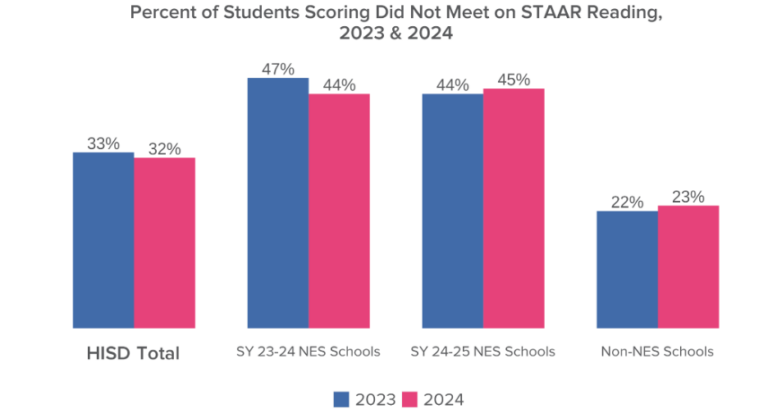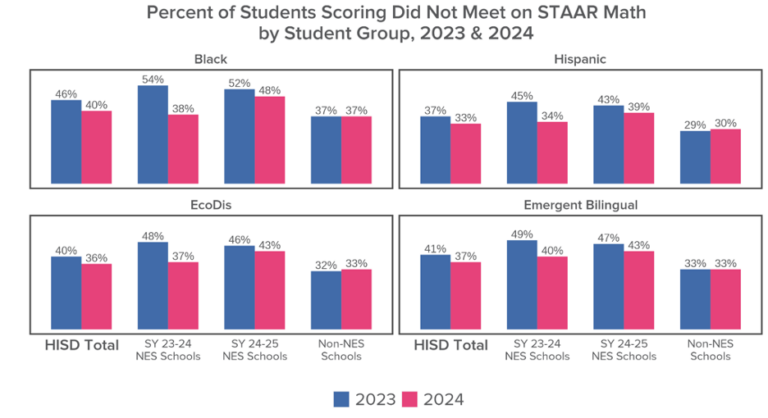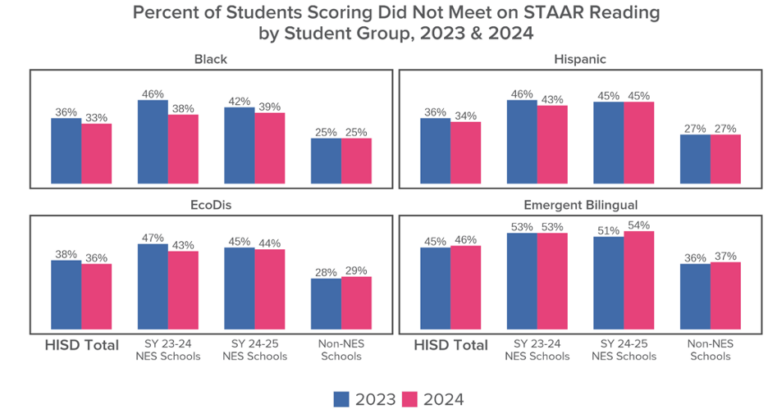Dear Partner,
Good Reason Houston’s research and data team continues to dig into STAAR results to see how well students are mastering key skills in core subjects. This month’s ConnectEd focuses on students who scored “Did Not Meet Grade Level” on last spring’s exams in Houston ISD.

Here’s a quick refresher on STAAR performance levels: Scores are categorized into four levels based on how many questions students answer correctly. The levels are:
- Did Not Meet Grade Level
- Approaches Grade Level
- Meets Grade Level
- Masters Grade Level
Students scoring at Approaches or higher are considered to have passed. If 25% of students scored Did Not Meet, it means 75% scored at Approaches or above, with some of those reaching Meets or Masters levels.
While much of the media and district updates has highlighted HISD’s successes in increasing students at the Meets level or above, it’s also crucial to address those who scored Did Not Meet. This month’s ConnectEd looks at these students, who likely need extra support to ensure they’re receiving the education they deserve. On a positive note, HISD saw a significant drop in Did Not Meet scores recently, especially at New Education System (NES) campuses.
If you have questions or thoughts on the work highlighted here, feel free to reach out to us at info@goodreasonhouston.org, reply to this email, or join us on social media using #HTXConnectEd.

In this email, we’ll provide you with:
STAAR “Did Not Meet” Analysis | Data in the News
The Gist:
Below are key takeaways from this month’s Houston ConnectEd.
Overall, HISD students were 3 points less likely on STAAR math and 1 point less likely on STAAR reading to score Did Not Meet in 2024 than in 2023.
The most substantial improvements happened at the first cohort of NES campuses, which saw a 9-point drop in students scoring Did Not Meet in math and a 3-point drop in reading.
Looking at particular student groups, Black, Hispanic, and economically disadvantaged students at NES campuses saw even larger gains, especially in math.
Keep reading for a comprehensive perspective on Houston public education data.
2024 STAAR “Did Not Meet” Results in HISD
Our analysis of “Did Not Meet” results focuses on STAAR Math and Reading and includes results across campuses in HISD. This includes STAAR 3-8 as well as End of Course Examinations (EOCs) for English 1 and 2 and Algebra 1. We grouped individual campuses by their inclusion in the New Education System (NES) model to understand the first-year impact of the intervention on student achievement.
STAAR MATH: Across HISD, students were 3 points less likely to score Did Not Meet on STAAR math in 2024 than in 2023. These gains were concentrated in last year’s first cohort of NES campuses, which saw an encouraging 9-point decrease in the percent of students scoring at the Did Not Meet level. The 45 campuses being added to the NES system this year saw a smaller, but still significant, 3-point drop in students scoring Did Not Meet, matching the district-wide trend. Historically, these campuses have seen a much higher proportion of students scoring Did Not Meet than non-NES schools, so seeing them make progress in closing those gaps is encouraging.

STAAR READING: Improvements were more muted on STAAR reading, with only a 1-point decline in students scoring Did Not Meet across HISD. Like with math, though, students at NES campuses outpaced the district overall, seeing a 3-point drop in students scoring Did Not Meet.
A Brief Timeline of Ratings Since 2019

Along with these positive changes, a slightly higher proportion of students at non-NES campuses scored at the Did Not Meet level in both math and reading in 2024 than the previous year, so this is a trend to monitor in future years.
How This Looks Across Student Groups
Looking one level deeper, HISD’s NES campuses made particular progress with historically marginalized student groups. Black students at NES schools saw an astonishing 16-point drop in their likelihood of scoring Did Not Meet on math from 2024 to 2023. Hispanic and economically disadvantaged students at NES school both saw 11-point drops while emergent bilingual (EB) students saw a 9-point drop.
STAAR MATH: Students from these groups were also likely to score Did Not Meet on STAAR math at this year’s new NES campuses, although progress was not as significant as the first cohort of NES schools. Black, Hispanic, economically disadvantaged, and EB students at non-NES schools were about as likely to score Did Not Meet in 2024 as in 2023.

STAAR READING: Black students at NES schools also saw the largest improvements in STAAR reading, being 8 points less likely to score Did Not Meet. Though Hispanic and economically disadvantaged students at NES schools also saw improvements, progress overall among other student groups was more mixed in STAAR reading, particularly for EB students. Concerningly, EB students district-wide were actually slightly more likely to score Did Not Meet in 2024 than in 2023.

HISD’s 2024 STAAR results show mostly encouraging signs when it comes to ensuring fewer students are scoring Did Not Meet, particularly at NES campuses and especially in math. Still, we should all continue to closely monitor performance given the lack of progress at non-NES campuses and the lack of improvement for EB students in reading across the district. Efforts must be made this school year to sustain and expand upon the growth as we look towards 2025 STAAR results.
Data in the News
Here are some of the education-data news items we’ve been keeping our eye on over the past few weeks.
Recent research from Texas Tech highlights trends in the hiring and efficacy of uncertified teachers statewide – A recent research brief from Texas Tech’s College of Education examined trends around uncertified teachers in Texas. Nearly half of new teacher hires statewide in the 2022-2023 school year were uncertified teachers. The report found that students taught by inexperienced, uncertified teachers experienced learning loss equivalent to about four months in reading and three months in math, compared to those taught by traditionally certified teachers. Increasing access to high-quality teacher preparation pathways–both traditional and non-traditional–remains an important avenue to boost student learning.
TEA’s new data reporting system raises concerns about accuracy – The Texas Education Agency collects and reports massive amounts of data on education in Texas every year, including data on student performance, enrollment, postsecondary readiness, and attendance. During the 2023-2024 school year, TEA piloted a new data reporting system for districts to submit their data on these and other categories. The system has since expanded to include all districts in the state. Some districts who participated in the pilot have expressed concerns, however, that the new system does not provide opportunities for data validation and has returned numerous errors. TEA insists the system is accurate. We will keep an eye on this story as we prepare for January’s large Texas Academic Performance Reports (TAPR) data release.

